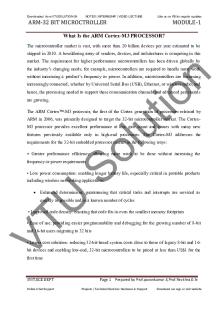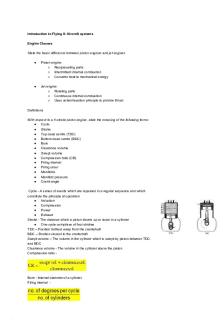EMBEDDED SYSTEMS: INTRODUCTION TO ARM ® CORTEX™-M MICROCONTROLLERS PDF

| Title | EMBEDDED SYSTEMS: INTRODUCTION TO ARM ® CORTEX™-M MICROCONTROLLERS |
|---|---|
| Author | Umair Shahbaz |
| Pages | 10 |
| File Size | 989 KB |
| File Type | |
| Total Downloads | 209 |
| Total Views | 489 |
Summary
EMBEDDED SYSTEMS: INTRODUCTION TO ARM ® CORTEX™-M MICROCONTROLLERS Volume 1 Fourth Edition Jonathan W. Valvano ii Jonathan Valvano Fourth edition May 2013 ARM and uVision are registered trademarks of ARM Limited. Cortex and Keil are trademarks of ARM Limited. Stellaris is a registered trademark Texa...
Description
Accelerat ing t he world's research.
EMBEDDED SYSTEMS: INTRODUCTION TO ARM ® CORTEX™-M MICROCONTROLLERS Umair Shahbaz
Related papers
Download a PDF Pack of t he best relat ed papers
Embedded Syst ems (Int roduct ion - Jonat han Valvano.pdf mahzoob yousaf Embedded Syst ems Int roduct ion t o Arm Cort exT M Microcont rollers vict or alfonso axpuac axpuac E M B E D D E D S Y S T E M S REALT IME INT ERFACEING T O ARM CORT EX M MICROCONT ROLLERS JON… mahzoob yousaf
EMBEDDED SYSTEMS: ARM ®
INTRODUCTION TO CORTEX™-M MICROCONTROLLERS
Volume 1 Fourth Edition
Jonathan W. Valvano
ii
Jonathan Valvano
Fourth edition May 2013
ARM and uVision are registered trademarks of ARM Limited. Cortex and Keil are trademarks of ARM Limited. Stellaris is a registered trademark Texas Instruments. Code Composer Studio is a trademark of Texas Instruments. All other product or service names mentioned herein are the trademarks of their respective owners.
In order to reduce costs, this college textbook has been self-published. For more information about my classes, my research, and my books, see http://users.ece.utexas.edu/~valvano/ For corrections and comments, please contact me at: [email protected]. Please cite this book as: J. W. Valvano, Embedded Systems: Introduction to ARM® Cortex™-M Microcontrollers, Volume 1, http://users.ece.utexas.edu/~valvano/, ISBN: 978-1477508992. Copyright © 2013 Jonathan W. Valvano All rights reserved. No part of this work covered by the copyright herein may be reproduced, transmitted, stored, or used in any form or by any means graphic, electronic, or mechanical, including but not limited to photocopying, recording, scanning, digitizing, taping, web distribution, information networks, or information storage and retrieval, except as permitted under Section 107 or 108 of the 1976 United States Copyright Act, without the prior written permission of the publisher. ISBN-13: 978-1477508992 ISBN-10: 1477508996
Jonathan Valvano
Table of Contents Preface to the Fourth Edition.................................................................... ix Preface........................................................................................................ x Acknowledgements ................................................................................... xi 1. Introduction to Computers and Electronics ........................................ 1 1.1. Review of Electronics..................................................................... 2 1.2. Binary Information Implemented with MOS transistors .............. 7 1.3. Digital Logic .................................................................................... 8 1.4. Digital Information stored in Memory ........................................... 16 1.5. Numbers .......................................................................................... 17 1.6. Character information .................................................................... 29 1.7. Computer Architecture................................................................... 30 1.8. Flowcharts and Structured Programming .................................... 33 1.9. Concurrent and Parallel Programming ......................................... 37 1.10. Exercises....................................................................................... 40 2. Introduction to Embedded Systems..................................................... 47 2.1. Embedded Systems........................................................................ 48 2.2. Applications Involving Embedded Systems ................................ 50 2.3. Product Development Cycle .......................................................... 53 2.4. Successive Refinement.................................................................. 57 2.5. Quality Design ................................................................................ 60 2.5.1. Quantitative Performance Measurements ....................................... 60 2.5.2. Qualitative Performance Measurements ......................................... 61 2.5.3. Attitude ................................................................................................. 61 2.6. Debugging Theory .......................................................................... 63 2.7. Switch and LED Interfaces............................................................. 66 2.8. Introduction to C............................................................................. 69 2.9. Exercises......................................................................................... 77 3. Introduction to the ARM® Cortex™-M Processor ............................... 79
iii
iv
Jonathan Valvano
3.1. Cortex™-M Architecture..................................................................80 3.1.1. Registers................................................................................................80 3.1.2. Reset.......................................................................................................82 3.1.3. Memory.................................................................................................82 3.1.4. Operating Modes .................................................................................85 3.2. The Software Development Process..............................................85 3.3. ARM® Cortex™-M Assembly Language ........................................88 3.3.1. Syntax ....................................................................................................88 3.3.2. Addressing Modes and Operands ....................................................90 3.3.3. Memory Access Instructions..............................................................95 3.3.4. Logical Operations ..............................................................................97 3.3.5. Shift Operations ...................................................................................99 3.3.6. Arithmetic Operations ........................................................................101 3.3.7. Stack.......................................................................................................118 3.3.8. Functions and Control Flow ..............................................................120 3.3.9. Assembler Directives ..........................................................................122 3.3.10. First Example Project ........................................................................123 3.4. Simplified Machine Language Execution ......................................127 3.5. CISC versus RISC............................................................................131 3.6. Details Not Covered in this Book ...................................................132 3.7. Exercises..........................................................................................134 4. Introduction to Input/Output ..................................................................137 4.1. Stellaris® LM3S/TM4C I/O pins ......................................................138 4.1.1. LM3S811 I/O pins ...............................................................................139 4.1.2. LM3S1968 I/O pins .............................................................................141 4.1.3. Stellaris® LM4F120/TM4C123 LaunchPad I/O pins ....................144 4.2. Basic Concepts of Input and Output Ports ...................................148 4.2.1. I/O Programming and the Direction Register ................................150 4.2.2. Switch Inputs and LED Outputs .......................................................156 4.3. Phase-Lock-Loop ............................................................................166
Jonathan Valvano
4.4. SysTick Timer ................................................................................. 170 4.5. OLED Display Driver and the printf Function............................... 175 4.6. Debugging monitor using an LED................................................. 179 4.7. Performance Debugging ................................................................ 179 4.7.1. Instrumentation ................................................................................... 179 4.7.2. Measurement of Dynamic Efficiency ............................................... 180 4.8. Exercises......................................................................................... 181 4.9. Lab Assignments............................................................................ 183 5. Modular Programming........................................................................... 185 5.1. C Keywords and Punctuation........................................................ 186 5.2. Modular Design using Abstraction ............................................... 190 5.2.1. Definition and Goals ........................................................................... 190 5.2.2. Functions, Procedures, Methods, and Subroutines........................ 192 5.2.3. Dividing a Software Task into Modules .......................................... 193 5.2.4. How to Draw a Call Graph ................................................................ 196 5.2.5. How to Draw a Data Flow Graph ..................................................... 198 5.2.6. Top-down versus Bottom-up Design ............................................... 199 5.3. Making Decisions ........................................................................... 200 5.3.1. Conditional Branch Instructions ....................................................... 200 5.3.2. Conditional if-then Statements..................................................... 202 5.3.3. switch Statements ............................................................................. 207 5.3.4. While Loops ......................................................................................... 209 5.3.5. Do-while Loops.................................................................................... 210 5.3.6. For Loops .............................................................................................. 210 5.4. *Assembly Macros.......................................................................... 212 5.5. *Recursion....................................................................................... 214 5.6. Writing Quality Software ................................................................ 218 5.6.1. Assembly Language Style Guidelines.............................................. 218 5.6.2. Comments............................................................................................. 223 5.6.3. Inappropriate I/O and Portability .................................................... 224
v
vi
Jonathan Valvano
5.7. How Assemblers Work....................................................................225 5.8. Functional debugging .....................................................................226 5.8.1. Stabilization ..........................................................................................226 5.8.2. Single Stepping ....................................................................................227 5.8.3. Breakpoints without Filtering............................................................227 5.8.4. Instrumentation: Print Statements ....................................................228 5.9. Exercises..........................................................................................228 5.10. Lab Assignments...........................................................................230 6. Pointers and Data Structures ................................................................231 6.1. Indexed Addressing and Pointers..................................................232 6.2. Arrays ...............................................................................................235 6.3. Strings ..............................................................................................240 6.4. Structures ........................................................................................242 6.5. Finite State Machines with Linked Structures ..............................244 6.5.1. Abstraction ...........................................................................................244 6.5.2. Moore Finite State Machines..............................................................245 6.5.3. Mealy Finite State Machines ..............................................................250 6.6. *Dynamically Allocated Data Structures .......................................252 6.6.1. *Fixed Block Memory Manager.........................................................253 6.6.2. *Linked List FIFO ................................................................................254 6.7. *Matrices ..........................................................................................257 6.8. *Tables..............................................................................................262 6.9. Functional Debugging.....................................................................265 6.9.1. Instrumentation: Dump into Array without Filtering ...................265 6.9.2. Instrumentation: Dump into Array with Filtering. ........................266 6.10. Exercises........................................................................................267 6.11. Lab Assignments...........................................................................270 7. Variables, Numbers, and Parameter Passing.......................................271 7.1. Local versus global .........................................................................272 7.2. Stack rules .......................................................................................274
Jonathan Valvano
7.3. Local variables allocated on the stack ......................................... 276 7.4. Stack frames ................................................................................... 278 7.5. Parameter Passing ......................................................................... 281 7.5.1. Parameter Passing in C....................................................................... 282 7.5.2. Parameter Passing in Assembly Language...................................... 284 7.5.3. C Compiler Implementation of Local and Global Variables......... 287 7.6. Fixed-point Numbers...................................................................... 289 7.7. Conversions.................................................................................... 293 7.8. LCD Interface with the HD44780 Controller.................................. 295 7.9. *IEEE Floating-point numbers ....................................................... 300 7.10. Exercises....................................................................................... 305 7.11. Lab Assignments.......................................................................... 308 8. Serial and Parallel Port Interfacing....................................................... 309 8.1. General Introduction to Interfacing............................................... 310 8.2. Universal Asynchronous Receiver Transmitter (UART).............. 312 8.2.1. Asynchronous Communication ........................................................ 314 8.2.2. LM3S/TM4C UART Details .............................................................. 316 8.2.3. UART Device Driver........................................................................... 318 8.3. Synchronous Serial Interface, SSI ................................................ 320 8.4. Scanned Keyboards ....................................................................... 324 8.5. Binary actuators ............................................................................. 325 8.5.1. Interface ................................................................................................ 325 8.5.2. Electromagnetic and Solid State Relays ........................................... 327 8.5.3. Solenoids............................................................................................... 328 8.6. *Pulse-width modulation................................................................ 329 8.7. *Stepper motors.............................................................................. 330 8.8. Exercises......................................................................................... 335 8.9. Lab Assignments............................................................................ 336 9. Interrupt Programming and Real-time Systems.................................. 337 9.1. I/O Synchronization ........................................................................ 337
vii
viii
Jonathan Valvano
9.2. Interrupt Concepts ..........................................................................342 9.3. Interthread Communication and Synchronization........................346 9.4. NVIC on the ARM® Cortex™-M Processor ....................................348 9.5. Edge-triggered Interrupts ...............................................................353 9.6. SysTick Periodic Interrupts ............................................................360 9.7. Timer Periodic Interrupts................................................................362 9.8. Hardware debugging tools .............................................................366 9.9. Profiling............................................................................................367 9.9.1 Profiling using a software dump to study execution pattern ........367 9.9.2. Profiling using an Output Port..........................................................368 9.9.3. *Thread Profile .....................................................................................369 9.10. Exercises........................................................................................370 9.11. Lab Assignments...........................................................................372 10. Analog I/O Interfacing ..........................................................................373 10.1. Approximating continuous signals in the digital domain..........373 10.2. Digital to Analog Conversion .......................................................375 10.3. Music Generation ..........................................................................377 10.4. Analog to Digital Conversion .......................................................381 10.4.1. LM3S/TM4C ADC details................................................................382 10.4.2. ADC Resolution .................................................................................385 10.6. Real-time data acquisition ............................................................386 10.7. Exercises........................................................................................387 10.8. Lab Assignments...........................................................................389 11. Communication Systems.....................................................................391 11.1. Introduction ...................................................................................391 11.2. Reentrant Programming and Critical Sections ...........................394 11.3. Producer-Consumer using a FIFO Queue ...................................399 11.3.1. Basic Principles of the FIFO Queue.................................................399 11.3.2. FIFO Queue Analysis ........................................................................405 11.3.3. FIFO Queue Implementation...........................................................406
Jonathan Valvano
ix
11.3.4. Double Buffer..................................................................................... 409 11.4. Serial port interface using interrupt synchronization ............... 410 11.5. *Distributed Systems.................................................................... 414 11.6. Exercises.............................................................
Similar Free PDFs

ARM Microcontroller & Embedded Systems
- 141 Pages

embedded systems assignment
- 8 Pages

Embedded Systems Unit - 1
- 99 Pages

Embedded-Systems-Design
- 110 Pages

Introduction to Sensory Systems
- 4 Pages

Introduction to Digital Systems
- 222 Pages

Embedded Systems Notes - Unit - 3
- 11 Pages

Micro C - embedded systems notes
- 4 Pages
Popular Institutions
- Tinajero National High School - Annex
- Politeknik Caltex Riau
- Yokohama City University
- SGT University
- University of Al-Qadisiyah
- Divine Word College of Vigan
- Techniek College Rotterdam
- Universidade de Santiago
- Universiti Teknologi MARA Cawangan Johor Kampus Pasir Gudang
- Poltekkes Kemenkes Yogyakarta
- Baguio City National High School
- Colegio san marcos
- preparatoria uno
- Centro de Bachillerato Tecnológico Industrial y de Servicios No. 107
- Dalian Maritime University
- Quang Trung Secondary School
- Colegio Tecnológico en Informática
- Corporación Regional de Educación Superior
- Grupo CEDVA
- Dar Al Uloom University
- Centro de Estudios Preuniversitarios de la Universidad Nacional de Ingeniería
- 上智大学
- Aakash International School, Nuna Majara
- San Felipe Neri Catholic School
- Kang Chiao International School - New Taipei City
- Misamis Occidental National High School
- Institución Educativa Escuela Normal Juan Ladrilleros
- Kolehiyo ng Pantukan
- Batanes State College
- Instituto Continental
- Sekolah Menengah Kejuruan Kesehatan Kaltara (Tarakan)
- Colegio de La Inmaculada Concepcion - Cebu







